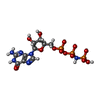+Search query
-Structure paper
| Title | Structural Insights into the Mammalian Late-Stage Initiation Complexes. |
|---|---|
| Journal, issue, pages | Cell Rep, Vol. 31, Issue 1, Page 107497, Year 2020 |
| Publish date | Apr 7, 2020 |
 Authors Authors | Angelita Simonetti / Ewelina Guca / Anthony Bochler / Lauriane Kuhn / Yaser Hashem /  |
| PubMed Abstract | In higher eukaryotes, the mRNA sequence in the direct vicinity of the start codon, called the Kozak sequence (CRCCaugG, where R is a purine), is known to influence the rate of the initiation process. ...In higher eukaryotes, the mRNA sequence in the direct vicinity of the start codon, called the Kozak sequence (CRCCaugG, where R is a purine), is known to influence the rate of the initiation process. However, the molecular basis underlying its role remains poorly understood. Here, we present the cryoelectron microscopy (cryo-EM) structures of mammalian late-stage 48S initiation complexes (LS48S ICs) in the presence of two different native mRNA sequences, β-globin and histone 4, at overall resolution of 3 and 3.5 Å, respectively. Our high-resolution structures unravel key interactions from the mRNA to eukaryotic initiation factors (eIFs): 1A, 2, 3, 18S rRNA, and several 40S ribosomal proteins. In addition, we are able to study the structural role of ABCE1 in the formation of native 48S ICs. Our results reveal a comprehensive map of ribosome/eIF-mRNA and ribosome/eIF-tRNA interactions and suggest the impact of mRNA sequence on the structure of the LS48S IC. |
 External links External links |  Cell Rep / Cell Rep /  PubMed:32268096 / PubMed:32268096 /  PubMed Central PubMed Central |
| Methods | EM (single particle) |
| Resolution | 3.0 - 14.3 Å |
| Structure data | EMDB-10760, PDB-6yal: EMDB-10761, PDB-6yam: EMDB-10762, PDB-6yan:  EMDB-10763:  EMDB-10764: |
| Chemicals |  ChemComp-SF4:  ChemComp-MG:  ChemComp-GNP: |
| Source |
|
 Keywords Keywords |  TRANSLATION / TRANSLATION /  initiation complex / 48S / initiation complex / 48S /  eIF1A / eIF1A /  eIF3 / eIF3 /  ABCE1 / ABCE1 /  rabbit / rabbit /  translation initiation / translation initiation /  eukaryotic initiation factor 1 / eukaryotic initiation factor 1A / eukaryotic initiation factor 1 / eukaryotic initiation factor 1A /  eukaryotic initiation factor 3 / late-stage initiation complex eukaryotic initiation factor 3 / late-stage initiation complex |
 Movie
Movie Controller
Controller Structure viewers
Structure viewers About Yorodumi Papers
About Yorodumi Papers











